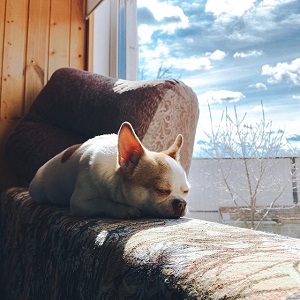After living with Stevie, our blind dog, for well over a year now, we have come up with our top tips for caring for your blind dog based on what has worked well for Stevie.
1. Talk to your dog…a lotYour dog is your most loyal companion, so they will want to know where you are at when you are home and your voice will be instrumental in calming any anxieties they may be experiencing. Your voice will also help them figure out where they are. Talk them through everything you will be doing when it involves them – ‘Okay, Stevie, let’s dry your paws off.’ ‘Hi, Stevie, it’s mom! I’m going to pet you now.’ By talking to them before you touch, you won’t startle them. Tell your dog if you expect something to make a loud noise, like running the blender, for example. Whenever we leave the room, we also tell Stevie where we are going so she isn’t as confused.
2. Keep a consistent routineYour pets’ internal clock will be off since they cannot perceive when it is day or night. By keeping a consistent routine your dog will build his or her confidence quickly and let them know what they should be doing. Even on days we do not need to wake up for work, we still set an alarm since this is Stevie’s cue that it is time to get out of bed for the night. Stevie might wake up before the alarm, but once she hears this cue, she knows it is okay to jump up to mom and dad. The first thing we do after the alarm is to take her outside for her first potty of the day. When we go on walks, we take Stevie on the same paths almost every time so she knows what to expect.
3. Let others know they are blindWhether its friends coming over to your house for a visit or a stranger wanting to pet your dog on a walk, let them know ahead of time they are blind so they can approach with caution. Just like we mentioned in the first tip, tell your dog ahead of time someone is going to pet them. Let the new person offer their hand first for your pup to smell. It might be helpful to get a leash/harness that lets other know your dog is blind. 4. White noise
At all times throughout the day, Stevie’s water fountain makes a trickling noise which not only lets her know where her food and water are but helps her orient herself in the house. Another way to do this is by leaving a radio on with the volume low, just loud enough to create some white noise. When we leave the house knowing we will be a gone for several hours, we will put a youtube playlist of calming music on.
5. Choose toys that make noise and encourage nose workWithout their sight, your dog might be tempted to become more withdrawn. Use toys they make lots of noise or smell to keep their interest piqued. We used this bacon scented ball to teach Stevie how to play fetch. Hiding treats in a snuffle mat will encourage nose work and provide lots of entertainment for them.
6. Be patientMost importantly, be patient! Your pet is going through a big adjustment in their life. You will both need time to adapt to this change. In no time, your pet will be navigating life with confidence.
